The Owl
Foundation is divided into two main areas: one for forest species and
the other for grassland species.
Our 250 enclosures are organized into 53 complexes, or 36,000 sq. ft of
cage space and each is designed to reflect our specific goals.
Admission
Upon admission, an owl will usually be placed in our Intensive Care Room (ICR) if it is small, or one of our larger indoor cages if it is a larger species. ICR is a quiet, warm, clean and safe environment developed to allow for continual monitoring and treatment of sick or otherwise unwell owls. Most of these units are equipped with heat lamps for additional temperature regulation.
Orphaned Chicks
On average, The Owl Foundation receives over two dozen owlets each spring. It is imperative that young owls are raised in a natural environment by adults of their own species if they are ever to be successfully released back into the wild. As such, The Owl Foundation prides itself on maintaining foster parents of Ontario's native owl species. Nestlings received at our facility are placed with non-releasable adults who feed and tend to these young, impressionable chicks until they have fledged and can fend for themselves. Our Intensive Care Unit is perfect for keeping young birds warm, calm and safe while TOF staff attend to any injuries and decide which foster parent pair is most suited to the needs of individual chicks.
Hospital Cages
Once an owl has recovered it will be placed in an outdoor cage to allow it more space, fresh air and a natural photoperiod. These are all important factors in maintaining health. Small birds are "weathered" in small outdoor Hospital Cages before being placed in larger breeding, overwintering or release training cages. The weathering process is a period of time where an owl gets used to or "habituates" to its environment - in this case, the outdoors. This is particularly important for owls that arrive during winter as the difference between the indoor and outdoor temperatures can be quite extreme.
Hospital cages are 24 sq. ft. (or about 108 cubic ft) and insulated to buffer much of the wind and rain. They act as a "middle man" between the ICR and large cages.
Unreleasable owls are incorporated into our unique breeding program. Wild chicks (mentioned above) are placed with proven non-releasable foster parents in these breeding facilities as well.
In designing our breeder cages, special consideration for species life histories and past experience must be made.
Corridors
All of the cages are joined to at least one other cage via a corridor
system. These systems can be opened or closed with gates depending on
season and owl inhabitants. They are incredibly useful for both pair formation
and non-intrusive juvenile dispersal from a parental "territory."
As well, many cages can be divided in two if owls require separation from
each other.
Nesting Sites
Our breeder cages are designed with nesting sites (owls do not build their
own nests, though some create very rudimentary ground "scrapes").
These can be either platform nests or nesting boxes, depending on the
owl species in question. We provide several different sites within a given
cage, as well.
Vegetation
As vegetation is a natural component of a wild owl's habitat, we try to
let as much vegetation grow in the cages as possible. This includes trees,
shrubs, flowering plants and grasses. Some units are selectively weeded
to ensure that the crippled inhabitants do not become entangled. This
is particularly crucial for ground species such as Short-Eared, Burrowing
and Snowy Owls.
Perching
We provide the owls with many options for perching. This includes perches
that are high, low, wide, narrow or even slanted as ramps. Owls can be
in full view of human passers-by, or completely hidden. An owl can choose
where to roost, fly and eat a meal. If it is scared, it can hide (either
from humans, or from a cage-mate). Our goal is to provide territories
(cages) where owls can feel secure and stress is minimized. We use natural
tree limbs as much as possible and will attach astroturf to any lumber
used to avoid bumblefoot.
We will even add more "greenery" (usually cedar branches) around
existing perches to provide nooks for the owls to shelter if there are
no naturally growing trees. As a result, many of the birds are not visible
during our annual tours.
Wall & Roof Design
All cages are designed such that an owl can choose to be protected from
the elements (wind, precipitation, sun, etc) or not. Each wall and roof
has a combination of wire mesh and sheeting to create both sheltered and
unsheltered areas. For example, during a rain storm an owl can choose
to shelter itself or bathe in the rain. However, an owl at TOF can choose
to bathe at any time since each unit includes a shallow cement pool (much
like a bird bath).
Roost Boxes
Several owl species are cavity nesters and some individuals prefer
to hide in cavities during the day. Thus, many of our cages have multiple
roost boxes available for owls that want a dark, enclosed area to hide
in.
Food Boxes
Each of our cages is designed with at least one "food box."
This is a covered ledge (accessible from the outside through a small latched
door) within the unit where food can be placed. This way the food doesn't
become obscured in ground cover (remember, dead food makes no noise!)
and will not get wet if it rains. In winter we place specially designed
heat trays within the boxes to keep mice and water from freezing.
Mesh
Due to the recent impact of West
Nile Virus (WNV) on our wildlife and particularly TOF's northern owls,
we have selectively outfitted breeding cages with mosquito netting. This
netting covers the entire outside of the cage and prevents blood sucking
insects from reaching susceptible birds.
Release
Training Cages
Releasable owls are placed into training cages. We utilize several different
cage types, each designed for species with different hunting requirements.
Here they hone their hunting abilities on a variety of live prey. These
units are typically longer than breeder cages and incorporate less high
vegetation to ensure that the owls are obtaining enough flight time and
space to gain muscle strength and stamina.
This is our newest facility and one of our most important. It consists of eighteen individual units (five at 8 x 10 ft, twelve at 6 x 10 ft and one exam room), each protected from the others and completely insect-proof. After the devastation we experienced in 2002 with the onslaught of West Nile Virus, we decided that TOF required an area where we could house sick owls and/or owls in the process of receiving the equine vaccine.
In 2003, we used the Isolation Complex to house owls involved in important WNV research conducted through the Ontario Veterinary College. University of Guelph. This information will greatly expand our knowledge of how this virus is affecting our North American owls and may help us secure their safety.
Cameras
Many of our breeding and release training cages are equipped with cameras
that send signals directly to a "Monitor Room". This is where
we watch over thirty-five high definition monitors and record interesting
and important behaviours onto video for future reference. Wild owls act
differently when humans are nearby than they do when they are alone. Therefore,
using our cameras allows us a clearer perspective on natural, typical
owl behaviours. Every North American owl species has been or is currently
being monitored remotely at The Owl Foundation using this technology.
The Mouse House
Here is where we receive and organize our weekly shipment of approximately 1500 mice and rats. We have several volunteers who have generously donated their time for many many years to help on "mouse days". We only provide live animals to owls undergoing release training.
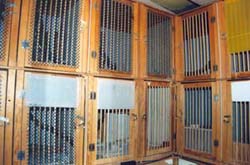
Our smaller ICR units can be divided or amalgamated based on a patient's
requirements.
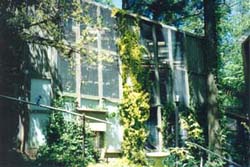
A Hawk Owl breeding cage where one owl family might be raised.
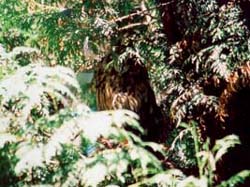
Green spaces within a cage provide shelter and refuge for wild owls.
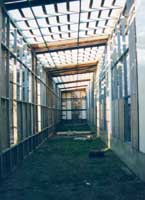
One of our 84 ft. release training units for
Great Horned and Snowy Owls.
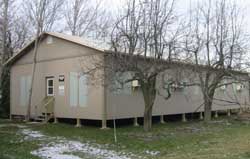
Our newest complex is Isolation - a facility completely sealed from WNV vectors. It consists of 18 individual units. The windows are covered in this photograph to retain heat.
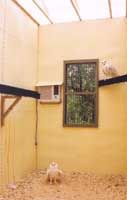
Each Isolation unit includes a semi-transparent roof, lighting (for dark days), perches, cedar chip bedding, an air conditioner and at least one screened window. Some are also equipped with heat lamps.
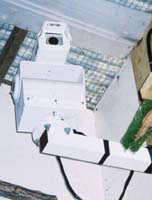
A Pan-Tilt Camera. One of two
types of cameras used at TOF.
Photograph courtesy of Carol Ricciuto.
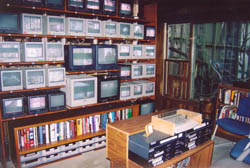
Over 35 remotely controlled cameras and monitors allow for discreet viewing of the owls.
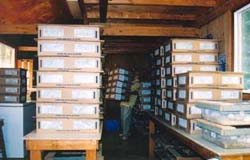
A typical Tuesday in the Mouse House